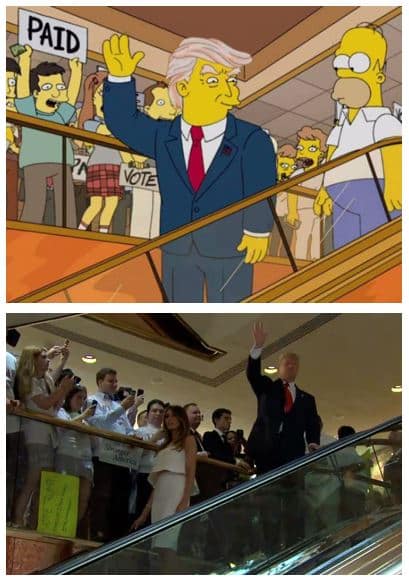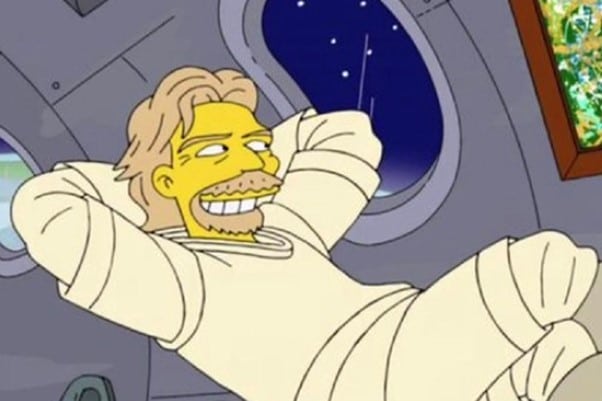The longest running scripted prime-time series in the US is The Simpsons, the animated sitcom which started its regular run in December 1989. Barring a writer’s strike here or a cast walkout there, The Simpsons has been in regular production since – and with the same principal cast (though as a feat it is arguably beaten out by Last of the Summer Wine, which ran for 37 years with the same cast before its cancellation in 2010).
Much as I would love to make this the inaugural installment of ‘Mike Talks About Old TV’, I actually wanted to talk about a long-standing myth – one which has turned up in several social media memes and clickbait listicles this year – that being The Simpson’s apparent uncanny ability to predict the future. The most obvious of these is the ‘prediction’ of the election of Donald Trump as president of the United States.

A common juxtaposition you will see is a picture of Homer Simpson standing behind Donald Trump, as the latter descends an escalator to the cheers of fans. This still is often purported to have been taken from an episode named Bart to the Future, which aired in March 2000. And if a comparison is made between that still and the real-life footage of Trump announcing his presidential run from June 2015, the similarities are remarkable. The escalator, the cheering fans holding signs, the camera angle, and so on.
Of course, the very obvious rebuttal is that the still is not from Bart to the Future at all. It’s not even from an episode of The Simpsons! It is from a ninety-second short released directly to YouTuBe named Trumptastic Voyage, which sees Homer get caught in Donald Trump’s hair. This was published to YouTube on July 7 2015, almost a month after the real-life event which inspired it.
Even by the standards of psychic predictions, it’s a stretch to call something a prediction when it is made after the predicted event.
So why do people so often claim this still is from an episode which aired in March 2000? In Bart to the Future, Bart Simpson is given a glimpse into the year 2030, where he learns that his sister Lisa has just become president of the United States. In this sequence, Lisa makes a throwaway reference to having just succeeded President Trump.
Okay, this isn’t as strong as the escalator still, but nevertheless this is The Simpsons mentioning Donald Trump being president, some sixteen years before it happened, right? Except that this was just a gag, with Simpson’s writer Al Jean being on record as saying they just wanted a funny celebrity. Moreover, even in 2000 a Trump presidency wasn’t a stretch.
Until the late 60s, Ronald Reagan was just an actor. He became governor of California in 1967 and then eventually US president in 1981, this fact being the basis of a joke in the film Back to the Future, from which Bart to the Future takes its name. So the idea of a celebrity becoming US president certainly wasn’t new.
Not only that, but Trump had been publicly flirting with the idea of running for President as far back as late 80s, even making a brief run in the New York primaries in 1999. He eventually aborted that presidential bid on February 14 2000, just a month before Bart to the Future aired. Though given the long lead times typical to animation, it’s probable that Trump’s early presidential bid was still alive and well at the time the episode was written and animated.
Another prediction often touted by these sorts of lists is a sight-gag from a 2014 episode called The War of Art. In that episode, we briefly see Richard Branson floating in a spaceship, admiring a painting on the wall. But Richard Branson didn’t actually go into space until 2021 – some seven years later.

Except that Branson started Virgin Galactic, with the stated intention of running passenger flights into space, to great fanfare and publicity, in 2004 – a decade before The War of Art aired. It was no secret that Branson was one of a handful of individuals financing a private space programme. This wasn’t a prediction, it was a pop culture reference, something you would expect from a comedy like The Simpsons which features elements of satire.
So-called predictions of this flavour are actually very common. The supposed prediction of a viral pandemic caused by a new virus originating in China — which featured in the episode Marge in Chains from 1993 — certainly did pre-date COVID-19 by some margin. But didn’t predate the H3N2 flu pandemic of 1968, upon which the plot was based, according to the writer of that episode Bill Oakley. Nor did it pre-date the general warnings from experts that viral pandemics like this are inevitable and we should prepare for them, warnings which go back decades.
Another claimed prediction is that of Facetime and Zoom, from a 1995 episode which features a fortune teller who predicts Lisa’s future and includes Marge calling her on video. Sure, this pre-dated FaceTime, which was announced by Apple in 2010, but it doesn’t pre-date the idea of adding video to a phone call. Star Trek had video calling back in the 60s, so did Doctor Who, and a dozen other sci-fi stories.
Even outside the realm of fiction, there were publicly marketed products which featured video calling — albeit primitive — marketed as far back as the 1980s. The concept of video-conferencing was so obvious and natural a next-step in telephone technology, there are even references to it in the 1800s. This wasn’t the Simpsons “predicting FaceTime”.
Some of these predictions are even more tenuous. In the episode The City of New York vs Homer Simpson, which aired in 1997, Lisa holds up a pamphlet advertising a coach trip from Springfield to New York City for just $9. On the front cover of the pamphlet is the phrase New York, a big price flash saying $9 – and behind it the New York skyline, including the empire state building and — this being 1997 — of course the towers of the World Trade Center.

But some people claim that the big 9, alongside the towers which themselves look like an 11, means this is a reference to 9/11 — even though this was four years before it happened. Therefore this is a prediction of the future, or maybe evidence the whole thing was planned by the Illuminati, who decided for some reason to foreshadow it in an episode of The Simpsons.
Of course, this doesn’t say 9/11. It is an advert for a bus trip to New York for $9 – so of course, it has a picture of a bus, of New York, and the price of $9. The writer of this episode, Bill Oakley, commented on twitter “$9 was picked as a comically cheap fare… to make an ad for it, the artist logically chose to include a silhouette of NYC. It’s pretty self explanatory.”
I must admit, this is one of the hardest of the ‘predictions’ for me to understand, because it predicts no such thing. It doesn’t predict an attack, or the towers falling… it doesn’t even say 9/11. It just says 9 and a picture of New York. Everything else is in the imagination of the viewer.
The final alleged prediction I want to talk about is from the episode When You Wish Upon a Star, which aired in 1998. Again, this features a brief sight-gag where we see the logo of 20th Century Fox — and underneath is the strapline, “A division of the Walt Disney Company”. Of course, Disney did eventually purchase 20th Century Fox in 2017. So, again, was this a prediction?
Well, unlike the others we have talked about, it’s not like Disney had been publicly saying, hey we’re thinking about buying Fox for a couple of decades before going through with it. But, again, there is a historic context which makes this just a satirical sight-gag, not an eerie prediction of the future.

The US has four major broadcast networks – NBC, CBS, ABC, and Fox. There are a handful of others, like PBS, or the CW, but those are the major ones. NBC is currently owned by Comcast, CBS by Paramount, Fox is owned by the Fox Corporation — which comprises the parts of Fox which Disney did not buy. And ABC is owned by Disney.
ABC wasn’t founded by Disney, but it was acquired by Disney in 1996, just two years before When You Wish Upon A Star aired. As with a Trump Presidency, the notion of Disney buying up television networks wasn’t exactly groundbreaking. Exactly that had happened just before the episode was made. To joke about one of the other four studios being bought up too — and that studio being Fox, which at the time made the Simpsons — isn’t exactly a stretch.
There are many many more of these. The Simpsons predicted three-eyed fish. The Simpson’s predicted Kamala Harris’s outfit. The Simpsons predicted the Findus horse meat scandal. The Simpsons predicted Go-Pros or the Apple Watch. But when a show has been running for over thirty years, producing over 700 episodes, plus films, shorts, specials, comics, video games etc. That’s a whole lot of predictions – deliberate or otherwise – and confirmation bias will take care of the rest. Fans remember the hits and forget the misses, which makes the hits seem that much more remarkable.
As Simpson’s producer Al Jean told the NME, if you throw enough darts, you’re going to get some bullseyes.



